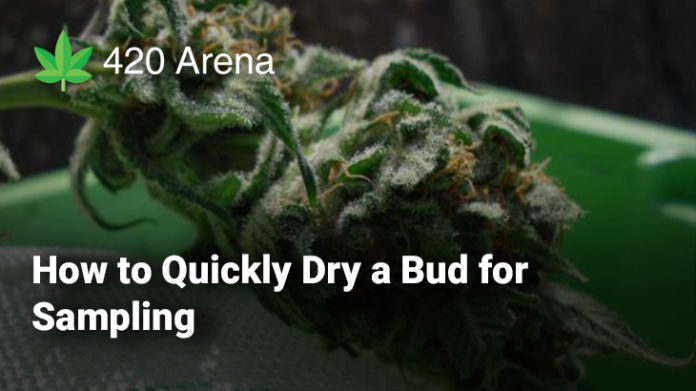Growing weed looks like an easy task at first but there’s quite the challenge to it when you look at the details. The process of growing marijuana does not simply end at the flowering stage – it actually needs to be dried and processed before you can smoke it up! There’s a lot of effort that goes behind every stage and the actual hard work begins once the flowering phase ends. In this article, we take a closer look at what’s next after flowering – how to quickly dry a bud for sampling, what are the processes of curing and harvesting, etc.
Our primary focus here is going to be on drying the buds, but we shall also take a detailed look at two other processes which happen along with the drying process – the harvesting and curing of buds as these three are essential for every grower to know! Professional scale growers would generally hire trained staff when their flowering phase comes to an end, as these are the people who specialize in curing, trimming, drying, processing, and harvesting the buds. However, when you do it on a small scale, you are doing everything by yourself! We hope that by the time you reach the end of this article, you will know what all these terms mean and get a basic idea about how to dry your buds, and what to do after the flowering phase is over.
However, before we continue with all of this discussion, it is essential to understand the terminology. We shall dive straight into that, but here’s a quick recap of how to reach the flowering stage: you start off growing your weed in the seed stage, from where it begins to germinate and then matures into the seedling phase. In this phase, you’ll need to provide a lot of blue lighting and allow the plant to grow taller and leafier. As it matures into an entity of its own it enters the vegetative phase, where a large number of leaves begin to appear and the stem becomes sturdy. Post that, the pre-flowering phase arrives where buds begin to appear and the sex of the plant becomes apparent, and when the lighting is reduced to 12 hours, it is triggered to enter the flowering phase when the flowers finally begin to show up!
All of these stages take 10-12 weeks depending on the strain of the marijuana plant that you are growing and whether it is an auto-flowering plant or a regular one, etc. However, the big question that we tackle here is: what after flowering? Now that you’ve reached the final phase of growing your plant, you will need to harvest it, and then there are some more steps that are to be followed. Here’s an explanation of all these terms that we talked about above:
What’s Next After Flowering: Understanding Harvesting, Drying, and Curing
Once your plants have reached the flowering phase, you will need to begin with the process of harvesting. The harvesting phase consists of multiple phases –
- Flushing
- Harvesting
- Drying
- Curing
- Storing
This is the post-flowering process that needs to be taken care of. Let us take a look at each of these terms in a greater detail:
- Flushing: Flushing is where harvesting starts at! Once you have decided the time for harvest, about a week or ten days before the actual date, you stop providing all extra nutrients and feed the plants only water (pH balanced). This ensures that any nutrients which have remained deposited in the body of the plant are consumed by the plant as you won’t be providing any extra doses. Besides, a supply of just water ensures that the end product is ‘purer’ and free of any extra chemicals/nutrients.
- Harvesting: When we talk about ‘harvesting’ here, we mean the actual act of cutting your weed. This is to be done by removing the larger fan leaves first. Once that is done, you can begin cutting the branches and the kolas. After you have removed the fan leaves and the branches, you can then proceed to remove the smaller leaves from the branches till only the flowers are left. A sharp pair of shears is to be used when doing this so that you get precise cuts and that you can do it with a greater efficiency than regular garden scissors.
- Drying: Drying the buds is the next big thing and the core topic of this article. Each of the branches that you have separated needs to be hung individually and also make sure that there’s enough gap between all of them. Ensure that there’s sufficient air circulation in the room where you are planning on drying your weed. You might also want to add a little heat to the room. Some growers, especially those who wish for privacy, prefer to dry their weed in ‘drying cabinets’. It is best advised to let the weed dry for at least a week before taking it down.
- Curing: The process of curing and trimming a bud is basically that of ensuring that all the extra leaves are gone, and that the bud looks like what we perceive a bud to normally look like. There are a number of tiny particles that tend to stick to the bud even after the drying and initial rounds of trimming. This is why the buds need to be manicured. People who cure the buds at industrial levels are trained professionals who spend hours devoted to this craft to make sure that the bud that they are trimming has a good-looking end result. They are also made to look sharper and pointier at the ends and less ‘hairy’. This is truly an art form!
- Storing: Once everything is done, you need to store your buds in a way that they are kept in airtight jars, but are allowed to ‘breathe’ or ‘burp’ twice a day for five minutes – this is a process that has to be followed for the first two weeks of your bud’s life cycle, after which it is ready to be consumed or shipped off!
How to Dry a Bud?
Up next is a detailed look at how to dry a bud. For this, we assume that you are done with the flowering phase, you have removed the large fan-leaves, and have separated the branches from the main plant. Next, you will need to choose an area in which you are going to dry your weed. We would assume, for the purpose of this article, that you are using a room for that and not a cabinet. A room is more convenient and a large number of people prefer to do it that way. The process would largely be the same for a cabinet (if you plant to do it that way), but would just be scaled down.
You will need to ensure that the room in which you are growing weed is as dark as possible. Weed dries the best in the absence of light. In addition to ensuring proper lighting conditions (or the lack of), you will then need to make sure that the airflow is just right. This is the most important aspect. The airflow needs to be top-notch and the room needs to be very airy. It is this air that will help dry your plants the most. A room with multiple fans and exhaust systems would be an ideal setup.
In your grow room, set up wires/ropes which run from wall to wall, and set hangers up on them. In each hanger, have one to two branches hanging in a ‘U’ shape. Ensure that there is sufficient distance between your branches so that the air can flow easily. Also, make sure that the air flow in the room is in such a way that it is not focused ‘at’ the plants but flows ‘around’ them.
Another thing that you might need to ensure is that there is no humidity in the room where you will be drying your weed. Humid air can actually be counterproductive to your efforts and it can either slow down the pace of drying or prevent that from happening. We strongly recommend using a dehumidifier if you happen to live in a humid area. Apart from low humidity, you would also need heating equipment. While room temperature works just fine, having a heating equipment will give you an extra edge.
All of this needs to be done for about a week, and check the status of the buds every few hours every day. In our experience, it usually takes about seven to ten days for weed to dry properly. In some cases, however, it might even take as many as two weeks or even more so keep checking regularly. One final bit of advice would be to never try and remove the buds from the drying process before at least four days which is when they become consumable (though not fully enjoyable).
How to Quickly Dry a Bud for Sampling?
The big question is – what to do if you are in a hurry? There are some methods which are bound to get quick results. While they are not even remotely effective as the good ol full-length drying process, they are indeed very helpful for sampling purposes. Note that this cannot be done on a large-scale and only a small bud or two can be quick-dried using these methods. Even then it won’t be as good as it would otherwise be, but for reasons of sampling, this is an acceptable method to use.
Here’s a quick look at some tips that you can implement to get your weed to dry quickly so that you could sample it right away –
- Microwaving the Bud:
One of the best and the quickest of ways to dry a bud is to microwave it. Set the oven at about 125F, let the bud be in there for five minutes, then take it out, turn it around and do it again for five minutes. If you are satisfied it is ready, if you are not, you might want to repeat it a couple of times. We strongly suggest to do this with the utmost safety as heating using electronic appliances might risk in fire-related mishaps.
- Fan and Paper Bags:
Keep a bud in a brown paper bag and hang it horizontally in a windy balcony. Make sure that it is open from the mouth but not so much that the weed may fall off. If done right, this will help you dry the bud in just 2 to 3 days (you might want to microwave it post that to get an even better effect). This is a quick-dry method for sampling purposes and might not yield ‘optimum’ results.
- Sunlight:
Lastly, this is the all-natural old-fashioned method. Unlike indoor growing where you turn the lights off, here you would depend upon the earth’s yellow sun to cast all its heat upon your weed and to turn it dry. If you are living in a place which is naturally blessed with lots of sunlight and heat this might just do the job for you in two to three days. Most growers avoid this because they don’t want to expose their weed to open air or to the public view. Besides you also need to protect it from any stray animals/pests/birds, as well as from rain and other elements of nature.
Drying Tips: Things You Must Ensure While Drying Your Marijuana Buds
Lastly, before we head into the frequently asked questions and the conclusion, here’s a look at some things that you need to consider while drying your marijuana buds:
- Keep humidity to minimal – This is a very important factor that you must always keep in mind. If you are growing your weed in a place that has a high humidity naturally, you will need to make sure that you are setting up a strong dehumidifier to counter that. This is because the whole purpose of drying your weed is to keep it away from humidity and moisture. The presence of extra humidity in the air would keep your buds moist even though the air tries to dry it.
- Provide extra heat if needed – In an overwhelming majority of the cases, you will be ok drying your weed in room temperature. However, there are some places where you will need to use a heater to provide some extra heat. Using a heater to crank up the temperature is only going to benefit you – but while doing this make sure that humidity levels are also maintained. Extra heat will help you dry up your buds faster than they would do under normal room conditions.
- Ensure all lights are off – Lights are detrimental to the drying process and as a practice used around the world, most growers tend to turn off all lights when they are drying their bud. These plants need to ‘cool down’ and the presence of light will only exert more pressure on to them. Hence, to make sure that your plants are drying up faster, keep all the lights off.
- Ensure proper airflow – Very important! Make sure that there is a lot of airflow in the room. There needs to be a combination of pedestal fans, exhaust fans, ceiling fans, and swiveling fans if you are growing at an industrial scale. At a small scale setup, just a regular ceiling fan would also be sufficient for most growers. However, ensure that fresh air is flowing into your room while you dry your plants.
- Ensure distancing between branches – One more thing that you need to keep in mind is that even here you will be required to follow proper social distancing. If you keep these branches hanging close to each other there will not be sufficient space for the air to flow through and to dry the buds. The more spaced out they are while you hang them to dry, the faster they will dry. This is a common principle you’d follow even when drying your clothes on a clothesline!
- Give it time – Last but not the least, be patient and give it a lot of time! Your plants need quite a bit of time to dry out. You’ve waited all these months to patiently grow them to produce the best and the finest of buds. You can wait a few more days to allow it to dry properly so that you get a great experience while you smoke them! Also, note that a fresh bud will always be a little moist even after it has fully dried – that is actually the sign of a healthy bud.
Frequently Asked Questions about Drying Marijuana Buds
Here are the answers to some of the most common and frequently asked questions about drying your marijuana buds that you need to know. We have collated these answers and put them together under this section for your ease and reference.
1. How long should I dry my buds for?
Well, the true answer to this question is – dry your buds for as long as it takes for them to get dry! This is a process which usually takes anywhere between a week to two weeks depending on the climate and the air around the buds, but as a rule of thumb, never take them off the drying cabinet/room before four days. This is the very least that you must keep in mind while drying your buds.
2. Does weed smell when you dry it?
Yes! This is another thing that must be known by the growers beforehand. When you are growing your weed, it smells quite a bit, but the stench peaks when you are drying it. It is at this time that your entire room and even the surroundings might stink of weed. It is best advised that you use some strong carbon filters in your drying cabinets and drying rooms so that they trap all the smell. The smell can be quite strong – and the more branches there are to dry the stronger this smell would be!
3. What is a drying cabinet and how to make it?
A drying cabinet is basically an enclosed structure that has enough space to hang your cut branches and sufficient airflow. This can be created using any cardboard box by lining it with black paper and having ducts and fans fitted in it. This ensures that you can have a safe space to dry your buds without them occupying your room and being visible. This also helps contain the smell to a smaller area so that the carbon filter can have ease in trapping the smell.
4. Is it compulsory to cure and trim your bud after you’ve dried it?
If you are an industrial grower who plans to sell his weed, this is something that you must do. However, if you plan to use it for personal consumption you need to make some small trimmings so that any debris/mud/sticks/twigs stuck on the bud are gone but you won’t necessarily need to shape the buds and make them look presentable (unless you really want to).
Conclusion
We hope that by the time you have reached the conclusion of this article, you know everything about the post-flowering stages, including but not limited to harvesting, drying, curing, and storing. However, the primary purpose of this article was to inform you about two things: firstly, how to dry your buds, and secondly, how to dry your buds in a ‘quicker’ way so that you can take them for sampling straightaway! We have gone above and beyond the regular answers to provide you with a three-sixty degree picture of everything around drying and we hope that this article helps you in drying your weed in the best way possible! If there are any more questions, feel free to send us a mail or let us know in the comments below and we shall get back to you soon! Till then…
…Happy Growing! 🙂
Table of Contents

















![How to Use Carbon Filters in Your Grow Room [7 Best Carbon Filters for Grow Rooms in 2021] How to Use Carbon Filters in Your Grow Room](https://420arena.com/wp-content/uploads/2020/12/How-to-Use-Carbon-Filters-in-Your-Grow-Room-218x150.jpg)










